All published articles of this journal are available on ScienceDirect.
The Integration of Transportation Modes for Bromo-Tengger-Semeru National Park
Abstract
Introduction:
The spread of the COVID-19 virus requires unprecedented steps from the government such as the restriction of travelers and activities and enforcement of social distancing to reduce interaction between individuals. This led to a drastic decrease in tourist visits to the TN-BTS between January and December 2020 with the area reported having been closed between April - July. Meanwhile, there was an inadequate transportation system at a tourist destination area before the pandemic and that made the movement more difficult during the pandemic. Therefore, this research is focused on describing transportation modes integration in the East Java-Indonesia TN-BTS area during this period.
Methods:
The intermodal integration was represented through the community's preference which was based on certain elements such as the need for connecting mode, main mode, multimodal network, transitional facilities, switching facilities with different networks, schedules integration, tariffs, routes, and times.
Results and Discussion:
The survey conducted, however, showed these indicators are below expectation as observed with the community satisfaction with transportation integration in the TN-BTS area measured to be very low, below 60%, using the Customer Satisfaction Index (CSI) tool. Moreover, the expectations on the variables for intermodal integration were also measured using Important Performance Analysis (IPA).
Conclusion:
The findings showed the policymakers and planners need to take steps to encourage the realization of transportation integration in the TN-BTS area to develop tourism in the area.
1. INTRODUCTION
Pneumonia plague was detected in December 2019 in Wuhan, China, and has been identified as a new contagious coronavirus currently named COVID-19 [1]. World Health Organization (WHO) declared the virus a pandemic on March 11, 2020, after its global spread and observed to have been in existence for over a year. The East Java Government in accordance with the Central Governments direction has, taken unprecedented action to prevent its transmission by implementing Large Scale Social Restrictions (PSBB). therefore, this had significant effects on the lives of people throughout East Java Province.
This research was conducted from April - December 2020, and the people were advised to work from home starting from April 2020 while tourism places, entertainment, cafes, restaurants, and schools were closed. They can conduct their activities freely if they comply with health protocols by wearing masks, washing hands frequently using soap, and maintaining a distance of 1.5 m from other people [2]. These guidelines were enforced strictly with violations attracting a penalty of IDR 250,000 fine which is equivalent to US $ 16.6.
These policies and the impact of the virus led to an extraordinary situation because people had to change their daily lives. This was radically observed in mobility and goods which are quite influential on transportation modes to different areas of the country [3]. Therefore,it is important to assess the effect of this pandemic on the transportation integration modes access to the Bromo-Tengger-Semeru National Park (TN-BTS) tourism area from the research and policy perspective.
The COVID-19 pandemic has affected public transport worldwide, and its implications need to be evaluated and studied in depth on all aspects of public transport. Therefore, an analysis needs to be made to examine the impact of the pandemic on public transport service quality decisions to have a better vision of the needs of different stakeholders to keep the system functioning profitably [4].
The condition of public transport modes of transportation in big cities in Indonesia, such as Jakarta, Surabaya, and Bogor, has an unbalanced ratio between demand and supply. The number of public transportation is less than private vehicles. The growth of road length with the number of motorized vehicles is very unbalanced. Motor vehicles per year grow about 10% while the road length grows only about 1%. Integration between modes in several big cities such as Surabaya, Jakarta, Medan, Makassar, and Denpasar has not been realized [5].
The East Java Province started the development of the TN-BTS Strategic area in 2019 but the integration of the transportation modes was discovered to be hampered by the pandemic despite the importance of this factor in developing this tourist area [6]. This was confirmed by the Head of the Jakarta - Bogor - Depok - Tangerang - Bekasi Transportation Management Agency under the Ministry of Transportation, Elly Adrian Sinaga, that the integration of transportation modes before COVID-19 was difficult due to the lack of coordination between the public transport operators. This consequently leads to inconveniences for the passengers [7].
Meanwhile in Padang City, West Sumatra, Train has not been integrated with other public transportation. This condition may indicate weak planning and management of public transport [8]. In Surakarta, public transport passengers feel that they are not protected in terms of security, safety, comfort, equality and order. For this reason, it is recommended to the government to optimize the procurement of public transportation facilities and infrastructure. Then public transport managers are advised to optimize their services. Then the service user community is encouraged to be more mature and alert in using public transportation [9].
The problems of public transportation in the city of Surabaya are inadequate fleets, inadequate infrastructure, low interest in public transport users, and the role of regulators and operators that have not been optimal. This can be seen from the unfavorable operating conditions. It is necessary to improve the operating fleet, service system, and operational and financial management by integrating all existing interests, to accommodate the needs of public transport users. Suggestions that can be given are: 1. the need for more intensive handling related to the management of public transportation so that it is more attractive to users, 2. handling needs to be done thoroughly because public transportation problems, both causes and solutions, are also related to other fields, and 3. the development of public transportation needs to be integrated with the city-building system as a whole [10].
The difficulty in integrating the transportation modes is predicted to become more difficult during this pandemic due to the reduction in the movement of passengers and goods in line with the Large-Scale Social Restrictions (PSBB). Meanwhile, the TN-BTS tourism area with a population of more than 1 million people, is expected to have an efficient transportation system operating effectively with other sectors such as the economic, social, and environmental aspects [11-13].
The development of the TN-BTS tourism area is a top priority due to its potential global impact which is predicted to be similar to the economic breakthrough recorded at the Bromo Marathon Sports Tourism Event. It is also expected to provide benefits to the social, economic, and environmental aspects by increasing the recognition of local cultural arts, building insights, creating jobs, increasing people's economic income, and building a clean and comfortable environment [14].
The development of transportation is also expected to improve the economic proximity of the province to the region towards the exploration of the tourism potentials [15] and improvement in the East Java economy [16]. This research was, therefore, conducted to determine the conditions of integrating transportation modes in the TN-BTS area during the COVID-19 pandemic. This involved the use of a survey to obtain primary and secondary data which were combined and analyzed to obtain a broad concept of the integration process.
The factor of integration of transportation modes in tourist areas is very important because it involves the smoothness and ease of reaching the destination. This study aims to determine the tourism potential of Bromo – Tengger – Semeru National Park (TNBTS), as well as identify and analyze aspects of transportation modes that need to be integrated into the tourist area of Bromo – Tengger – Semeru National Park (TNBTS). .
2. RESEARCH FRAMEWORK & METHODS
This study analyzed the transportation modes integrated into the TN-BTS tourism area during the COVID-19 pandemic. This section provides information on the framework and data collection methods used.
2.1. Research Framework
A research framework was developed through a literature review to compile and analyze data in order to show the conditions of the transportation mode integration in TN-BTS tourist areas during the COVID-19 pandemic. The concept of transportation mode integration was defined as a form of transportation system management that combines two or more modes of transport to achieve optimal service [17]. It ensures continuous and timely movement and door-to-door service for the passengers [18].
Transportation integration requires the consideration of 2 parameters which include the travel time and travel costs [19] while the multimodal public transport concept considers 6 factors [20] which are the Connecting Modes, Main Modes, Multimodal Networks, Transfer Points, Transitional Facilities Mode or Transfer Point with different networks, and supporting regulations.
Integration generally means the renewal and cohesiveness of parts to become a complete or unified whole [21]. Meanwhile, a mode is defined as a form or type of transportation and different modes are needed for both passengers and goods in Indonesia due to its archipelagic nature.
Network integration has also been explained to be the key to the success of a transportation service system in an area or city [22] due to its ability to determine the best route based on travel needs in the community and the delivery of optimal service. It also aids other aspects of transportation, such as the physical, schedule, and tariff integrated into the system [23]. Therefore, transportation mode integration is defined in this research as a complete integration of different types or forms of transportation to move people and goods from one place or origin to another [24].
2.2. Methods
2.2.1. Data
This study uses primary data and secondary data. Primary data was obtained by measuring the perception of 243 respondents on transportation integration in TN-BTS. Respondents consist of elements of domestic and foreign tourists, public transport operators, public transport associations, and the district transportation office.
Based on data analysis on the number of respondents as many as 243 respondents, the results of the significant value of sig (2-tailed) can be seen that the value of sig (2-tailed) between variable (Xn) and variable (Y) is 0.000 <0.05, which means there is significant correlation between the two variables. Apart from the questionnaires, interviews and observations were also conducted.
The secondary data was obtained from TNBTS tourist areas and attractions, transportation infrastructure in East Java, intermodal transportation and its network to and from TNBTS attractions, transportation fares, and intermodal integration data from and to TN-BTS attractions, and potential tourism data. Data were obtained from related agencies such as the East Java Provincial Transportation Service, Malang Regency Transportation Service, Probolinggo, Lumajang, and Pasuruan.
The study period was between April and December 2020 and the summary of the framework used in collecting data is presented in Fig. (1).

2.2.2. Analysis
This section discusses the main results and findings of the impact of the coronavirus pandemic on society using data collection with descriptive statistical analysis, Importance-Performance Analysis (IPA) and Customer Satisfaction Index (CSI). IPA uses 10 intermodal integration items: Intermodal Transport, Connection Mode, Main Mode, Multimodal Network, Transfer Point, Transfer Point with different networks, Route, Tariff, Schedule, and Time.
With the help of importance ranking, Sebastian Zenker reduces the item set to 21 distinct items, namely: Various cultural activities (theater, nightlife, etc.), Various shopping opportunities, Many different cultures and subcultures, City energy and atmosphere, Different services available, City image of the city, Openness and tolerance of the city, Amount of nature and public green areas, Environmental quality (low pollution), Number of parks and open spaces, Wide range of outdoor activities, Tranquility of place, Cleanliness of the city, Access to water, Overall wage rate general, Good job opportunities and promotions, General economic growth in a given area, Professional network in the city, Market/Recruitment housing costs, General price level in the city/Cost of living, and Availability of apartments and houses.
The 21 items that differed according to factor structure and factor loading were condensed into four highly correlated factors (all alpha > .74). The four factors are: Urbanity & diversity, Nature & recreation, Employment Opportunities, and Cost Efficiency [25].
To determine the CSI index in the area of public transport, we must conduct a large-scale survey of customer voices. The criteria for the quality of public transport that are most valued by passengers in the Slovak Republic are: Price, Timeliness, Security, and Comfort. This index can be used successfully in the area of improving the quality of public passenger transport. To implement the CSI method, transportation companies must constantly talk to customers about their wants and needs, take responsibility for further performance and encourage a better public transportation system for all customers. Based on the research conducted, it can be said that customer satisfaction with the services provided on passenger transportation is at a very low level [26] [27].
3. RESULTS AND DISCUSSION
3.1. TN-BTS for Indonesia
TN-BTS is important to Indonesia due to its inclusion in the icon of 10 global tourist destinations in the country. The first 5 super-prioritized destinations planned to be physically developed by the Central Government by the end of 2020 include Lake Toba, Borobudur, Mandalika, Labuhan Bajo, and Likupang followed by the next 5 which are Wakatobi, Bangka Belitung, Raja Ampat, Bromo-Tengger-Semeru National Park (TN-BTS), and Morotai as shown in Fig. (2).
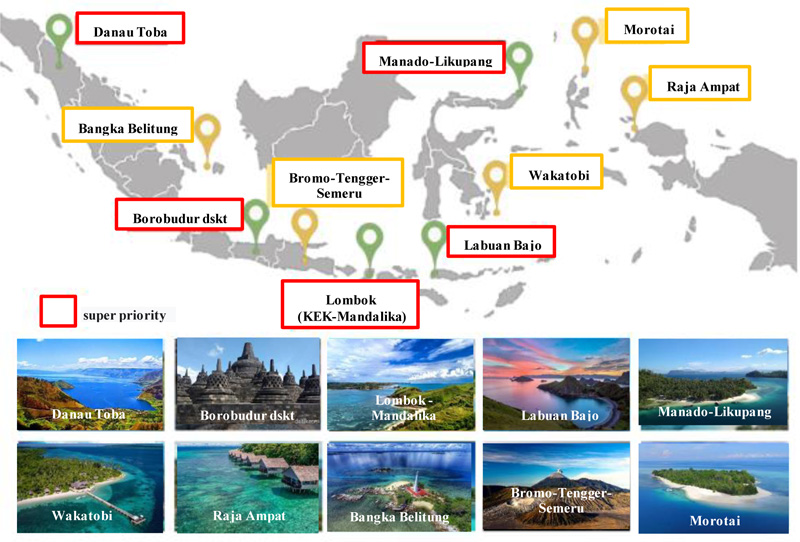
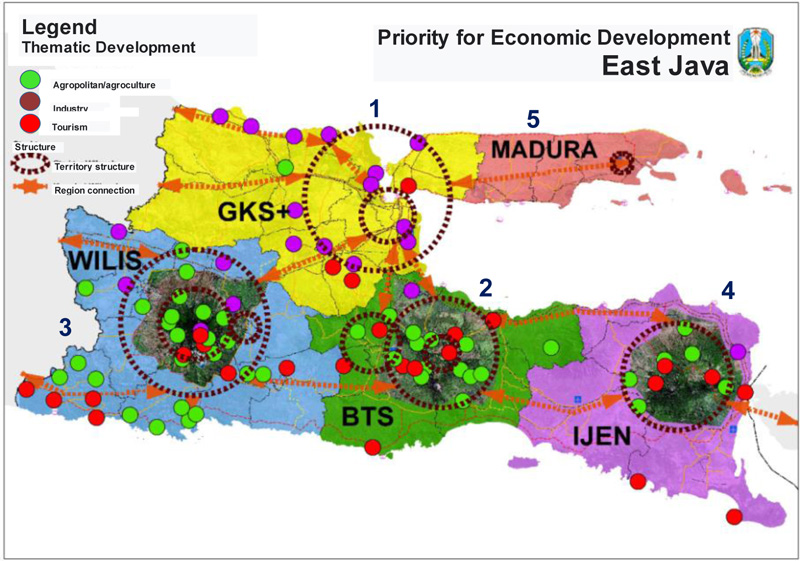
This is in line with the Government of Uzbekistan which has developed the tourism sector into one of the most important strategic sectors. The state government's top policy priority in tourism is to support its status as a strategic sector of the economy, and as a powerful tool for sustainable development [27].
East Java Province also prioritized the development of five regions in line with the plans of the central government. The first region includes Gresik Regency, Bangkalan, Mojokerto, Surabaya City, Sidoarjo, and Lamongan or Gerbangkertosusila (GKS) in the Surabaya metropolitan area. The second is the TN-BTS area, the third is the Selingkar Wilis area consisting of Nganjuk, Kediri, Tulungagung, Trenggalek, Madiun, and Ponorogo regencies, the fourth is the Ijen area which includes Banyuwangi Regency, and the fifth is the Madura Island area as shown in Fig. (3).
From the description above, it can be concluded that the tourism sector is a global sector, so every country has the same concern to develop it and has high economic value.
3.2. TN-BTS Tourist Area
The TN-BTS area is a national park located in East Java Province at approximately 20-30 km from west to east and 40 km from north to south. It was established in 1982 on approximately 50,276.3 hectares of land with a sand sea caldera on ± 6290 hectares covered with steep walls which are between 200 - 700 meters high, as shown in Fig. (4). TN-BTS is the only conservation area in Indonesia with a unique sand sea covering an area of 5,250 hectares at an altitude of ± 2,100 meters above sea level. It is located in the administrative areas of Pasuruan, Malang, Lumajang, and Probolinggo Regencies, as indicated in Fig. (5). The famous mountain icon in the area is the Bromo-Tengger-Semeru or BTS Geopark which is formed from a series of Bromo, Tengger, and Semeru mountains as shown in Fig. (6). The main tourist objects are the Mount Bromo crater panoramic view, cultural festivals, the Tengger tribe's kasada ceremony, and special events such as mountain jazz and the Bromo marathon
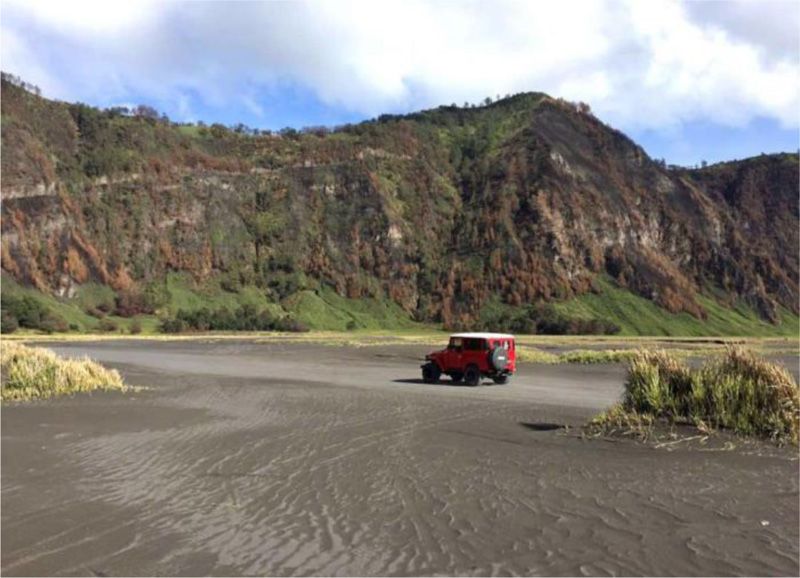
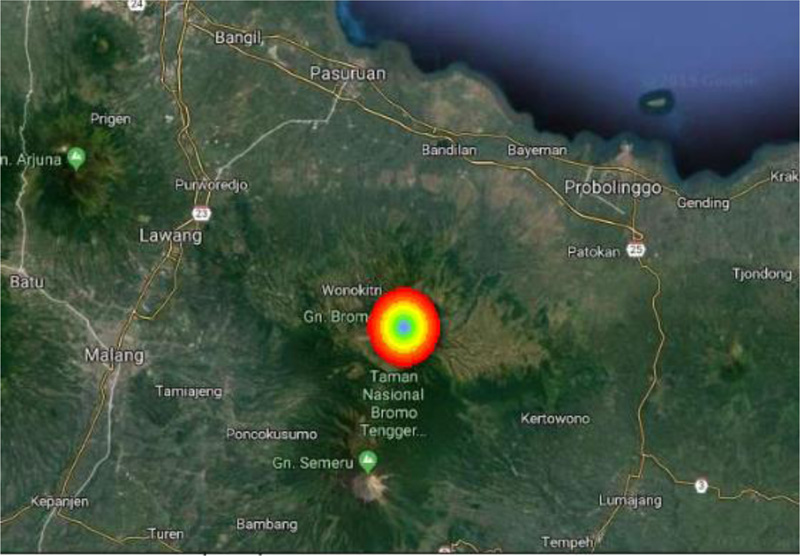

The condition of TN-BTS is almost the same as The Asinara National Park is unique in that it is located in a small area close to the large Italian island of Sardinia. A very interesting specific site in a protected area [28].
Source:https://velvetcandle.wordpress.com/2018/01/10/mount-bromos-sea-of-sand-travel-photography-east-java/
There are 3 natural tourism potentials in TN-BTS. The first is the Coban Trisula waterfall, Ranu Pani Lake, Ranu Regula, Ranu Kumbolo, and Ranu Darungan. The second is the Tengger Caldera and its surroundings including the sand sea, Mount Bromo, Mount Batok, Mount Widodaren, Simpang Dingklik, Savanna Plains, Teletabis Hill, Andasan Block, Mount Penanjakan. The third is the Mount Semeru with Ranupani Village, Pangonan Cilik savanna, Tanjakan cinta or Love Veer, Oro-oro Ombo, Cemoro cage, Kalimati, Arcopodo, and Mahameru peak.
There is also cultural tourism in the form of Tengger tribe traditional ceremonies such as Karo Day, Yadnya Kasada, and Unan-Unan, as well as traditional arts which have been existing since the Majapahit era such as the Sodoran and Ujung dances. Some of the places where these activities are held include the Luhur Poten Temple, which is a Hindu Tengger temple, the Holy Water Source of Goa Widodaren, Pendayangan Rondo Kuning Temple, Ngadas Temple, and Ngadas Vihara.
From the description above, it can be concluded that TN-BTS in East Java, Indonesia and Asinara National Park, which is located close to the large island of Sardinia in Italy, have similarities as a tourist area, and both are national parks that are protected nature reserves because they have unique characteristics separately.
3.3. Visitors
TN-BTS is an international standard tourist destination visited by several tourists from different countries every year before the pandemic. The annual data retrieved showed 237 foreign tourists from 21 countries visited Mount Bromo in 2019, as indicated in Fig. (7) and Table 1 with the most recorded to be from Australia with 63 tourists followed by Malaysia with 41, and Germany with 31. The number was observed to have increased to 1837 from 52 countries in 2020 with the highest recorded to be from France with 449 followed by China with 188, Germany with 182, and Poland with 175 as shown in Fig. (8) and Table 2.

| Code | Variable | Importance | Performance | Gap | ||
|---|---|---|---|---|---|---|
| Respondents Number | Average Value | Respondents Number | Average Value | |||
| X1 | Intermodal transportation | 243 | 3,92 | 243 | 2,85 | -1.07 |
| X2 | Connecting Modes | 243 | 3,85 | 243 | 3 | -0.85 |
| X3 | Main Modes | 243 | 3,69 | 243 | 3,08 | -0.61 |
| X4 | Multimodal network | 243 | 3,62 | 243 | 2,85 | -0.77 |
| X5 | Transfer Point | 243 | 3,46 | 243 | 2,62 | -0.84 |
| X6 | Transfer Point with different network | 243 | 3,62 | 243 | 2,77 | -0.85 |
| X7 | Route | 243 | 3,85 | 243 | 2,85 | -1 |
| X8 | Tariff | 243 | 3,85 | 243 | 2,46 | -1.39 |
| X9 | Schedule | 243 | 3,85 | 243 | 2,62 | -1.23 |
| X10 | Time | 243 | 3,85 | 243 | 2,62 | -1.23 |
| Average | 3,75 | 2,77 | -0.98 | |||

| Code | Variable | Importance | Performance | Gap | ||
|---|---|---|---|---|---|---|
| Respondents Number | Average Value | Respondents Number | Average Value | |||
| X1 | Intermodal transportation | 243 | 3,375 | 243 | 2,5 | -0.875 |
| X2 | Connecting Modes | 243 | 3,625 | 243 | 2,75 | -0.875 |
| X3 | Main Modes | 243 | 3,125 | 243 | 2,5 | -0.625 |
| X4 | Multimodal network | 243 | 3,25 | 243 | 2,625 | -0.625 |
| X5 | Transfer Point | 243 | 3,25 | 243 | 2,875 | -0.375 |
| X6 | Transfer Point with different network | 243 | 3 | 243 | 3,25 | 0.25 |
| X7 | Route | 243 | 3,25 | 243 | 2,875 | -0.375 |
| X8 | Tariff | 243 | 2,875 | 243 | 3 | 0.125 |
| X9 | Schedule | 243 | 3 | 243 | 2,625 | -0.375 |
| X10 | Time | 243 | 3 | 243 | 2,625 | -0.375 |
| Average | 3,175 | 2,7625 | -0.413 | |||
| Source: Processed from primary data, Surabaya, 2020 | ||||||
The foreign tourists visiting Mount Semeru are relatively lesser than those in Mount Bromo due to differences in the characteristics of these two objects. This is observed from the 313 tourists that visited Mount Semeru from 24 countries in 2019 with the highest recorded to be from Malaysia with 146 followed by Singapore with 37, South Korea with 25, Poland 17, Thailand 16, and China 14 as shown in Fig. (9) and Table 3. Moreover, only 3 tourists from 3 countries were recorded to have visited in 2020 consisting of Armenia, the Netherlands, and Switzerland as shown in Fig. (10).

| Code | Variable | Importance | Performance | Gap | ||
|---|---|---|---|---|---|---|
| Respondents Number | Average Value | Respondents Number | Average Value | |||
| X1 | Intermodal transportation | 243 | 3,86 | 243 | 2,79 | -0.57 |
| X2 | Connecting Modes | 243 | 3,64 | 243 | 2,79 | -0.85 |
| X3 | Main Modes | 243 | 3,71 | 243 | 2,79 | -0.92 |
| X4 | Multimodal network | 243 | 3,71 | 243 | 3 | -0.71 |
| X5 | Transfer Point | 243 | 3,71 | 243 | 2,79 | -0.91 |
| X6 | Transfer Point with different network | 243 | 3,86 | 243 | 2,86 | -1 |
| X7 | Route | 243 | 3,86 | 243 | 2,71 | -1.15 |
| X8 | Tariff | 243 | 3,93 | 243 | 2,71 | -1.22 |
| X9 | Schedule | 243 | 3,71 | 243 | 2,86 | -0.85 |
| X10 | Time | 243 | 3,93 | 243 | 3 | -0.93 |
| Average | 3,79 | 2,83 | -0.96 | |||
| Source: Processed from primary data, Surabaya, 2020 | ||||||

The number of tourist visits per month to the Mount Bromo and Semeru areas through 4 entrances experienced a very sharp decline from April to July 2020 due to the Covid-19 pandemic. The decrease was 100% due to the closure of the two tourist destinations during that period, as shown in Fig. (11). Meanwhile, the number began to increase in August 2020 until the time this research was conducted, with tourists obliged to comply with the health protocols that have been set.
Covid-19 has affected the management and perception of travel risk and its impact on risk management, service delivery, transportation patterns, distribution channels, avoidance of overcrowded destinations, cleanliness and security. Travelers believe that the Covid-19 pandemic has created tourist health anxiety and reduced tourists [29].
From the description above, it can be concluded that the TN-BTS tourist area in East Java, Indonesia, which at the beginning before the Covid-19 Pandemic was the prima donna of tourist destinations for domestic and foreign tourists, in the end, had to be affected by the tourism and transportation sector until it fell 100%.

3.4. Entrances and Stopping Points
The results showed that there were 4 entrances to the Mount Bromo and Semeru areas apart from the airport and train stations in Surabaya and Malang. However, the modes of transportation at the entrance are not yet integrated with each other [30]. This means that visitors have to take other routes to reach the location, such as Probolinggo, Pasuruan, Malang, and Lumajang Regencies which are commonly used to reach the two mountains as shown in Fig. (12).
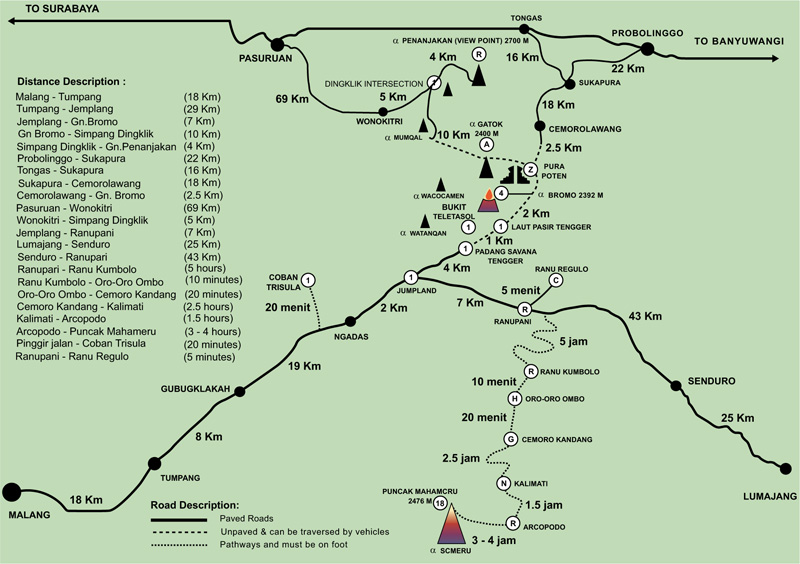
Wonokitri Tosari and Ngadisari are the last stopping points for public transport and this means specialized fleets such as jeeps and horses are required to reach tourist spots such as the Mount Bromo Caldera, Mount Bromo Crater and Mount Bromo's sea of sand. These fleets have different and unstable prices depending on the bargaining power of tourists.
The data shows that transportation modes that are integrated or diverted from airports and train stations in Surabaya and Malang to the Mount Bromo area and vice versa only occur once. This can be seen from the use of land transportation in the form of Damri buses as the main and connecting modes. This means that there are limitations on the integration of transportation modes, schedules, routes, and times, while fares have not been integrated at all
The routes for these entrances are as follows:
- Entrance from Pasuruan Regency to Wonokitri Village, Tosari Sub District, and then to the Mount Bromo or Semeru area.
- Entrance from Probolinggo Regency to Ngadisari Village, Sukapura Sub District, and then to the Mount Bromo or Semeru area.
- Entrance from Lumajang Regency to Senduro Village, Senduro Sub District, and then to the Mount Bromo or Semeru area.
- Entrance from Malang Regency to Tumpang Village, Tumpang Sub District, and then to the Mount Bromo or Semeru area.
These entrances do not have any transportation mode integrated to reach the Mount Bromo and Semeru area and this means tourists or visitors departing from the terminal or station in each regency/city have to change to another mode of transportation to reach their destination.
The lack of intermodal or integrated transportation system in these regencies also makes tourists use public and private or rented transportation from the bus and train stations as well as the ports in Probolinggo, Pasuruan, Malang Raya, and Lumajang regencies to the Mount Bromo area in addition to the use of Damri buses from Surabaya, Malang, and Batu.
Public transportation is in the form of medium-sized 4-wheeled vehicles which accommodate ± 10-20 passengers at unstable rates depending on the number of passengers. The rental transportation also makes use of the same type of vehicle but the schedules, travel times, and rates are not certain.
3.5. Integration of transportation modes at Juanda airport
Access to the TN-BTS, especially the Bromo area from Surabaya city, is based on the integration of air and land transportation through the use of the Damri bus as indicated in Fig. (13) and Table 3. Foreign and domestic tourists were able to start their visit from the gate of Surabaya City to TN-BTS through Pasuruan and Probolinggo to the Mount Bromo area.
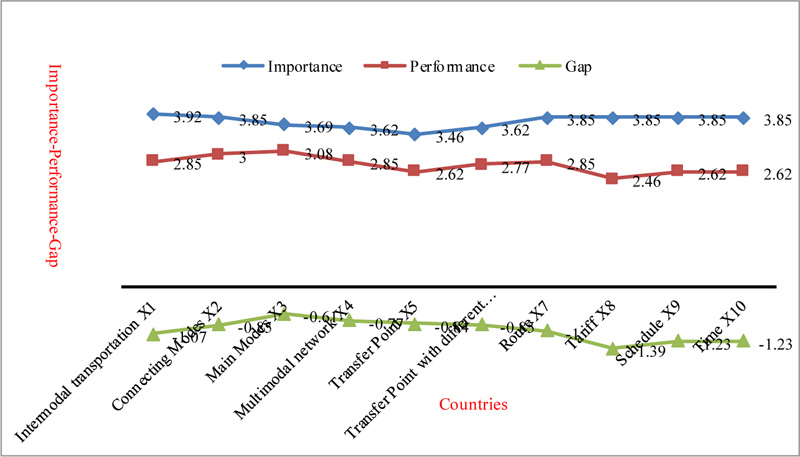
The tourists made use of the Damri public bus after arriving at the Juanda International Airport in Surabaya to reach the Mount Bromo area. The movement is usually from the Airport to Wonokitri, Pasuruan Regency with the departure schedule at 02.40, 03.40, and 05.40 pm at a rate of IDR. 46,000 which is equivalent to 3.1 US $. The return trip is also through the same route and rate but at 08.00, 09.00, and 11.00 am.
The quality of the integrated transportation from Juanda International Airport to the Mount Bromo area was observed not to be perfect as indicated in the average performance value of 2.77 which is below the required 3.75 based on the Importance-Performance Analysis shown in Fig. (13) and Table 1. This means the visitors' high expectations for multimodal variables have not been fulfilled. Therefore, there is a negative gap between expectations and reality on the 10 multimodal transport variables with a very low satisfaction index of 55.4% which is categorized as very poor.
In Amazonian cities, the integration of all modes of transport is a challenge for public transport city policy and for all regions. In the current situation, in the face of the social context empirically observed, it seems very clear the need for investment in transportation solutions, especially for the existence of economic and population activities; which has the downtown area as the most basic activity destination. In general, system integration seems a necessity [31].
3.6. Integration of transportation modes at Abdul Rachman Saleh Airport
Tourists and visitors can also start their visit to the Mount Bromo area from Abdul Rachman Saleh Airport, Malang using the Damri bus as shown in Fig. (14) and Table 2. The bus is used for departure after the tourists got off the plane and usually passed through Wonokitri, Pasuruan at 08.30, 09.30, 11.30, am and 02.30 pm at a rate of IDR 50,000 which is equivalent to 3.3 US $. The return trip is also at the same rate using the same route but the schedule is different - 01.15, 02.15, 04.15, and 07.15 pm.
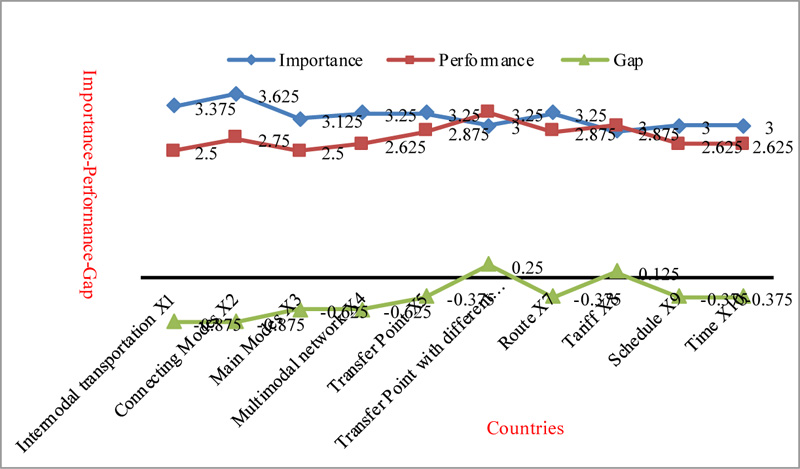
The transportation mode integration from both Abdul Rachman Saleh and Juanda International Airports to the Mount Bromo area has the same condition by not being perfect. This is evident from the average performance value of 2.76 obtained for this airport which is below the required 3.18 based on the Importance-Performance Analysis as shown in Graph 7 and (Table 2). However, the gap value is not entirely negative with 2 variables including transfer point with different networks and tariff, found to be positive. The satisfaction index is also 55.2% and this means it is very poor. (Fig. 14): IPA Of Abdul Rachman Saleh Airport
3.7. Integration of transportation modes at Gubeng Railway Station
Another point of departure besides the airport integrated with the Damri bus land mode is the Surabaya Gubeng Railway Station as shown in Fig. (15) and Table 3. Tourists or visitors alighting from the Station usually reach the Mount Bromo area through public transportation mode in the form of Damri bus via Sukapura, Probolinggo Regency with the departure scheduled for 08.00, 09.30, and 11.30 am at a rate of Rp 50,000 which is an equivalent of 3.3 US $. The return trip also follows the route at the same but the departure times are 02.00, 03.30, and 05.30 pm.
The transportation mode integrated into this station is land, as observed from the use of Damri Bus. Moreover, the conditions were observed to be similar to those recorded for the airports with the average performance value recorded to be 2.83 which is below the required 3.79 according to the Importance-Performance Analysis presented in Fig. (15) and Table 3. Therefore, the gap between the expectations and reality for the 10 multimodal transport variables has negative values while the satisfaction index is very low as observed from the 56.6% recorded. This, therefore, means the high expectations of visitors have not been fulfilled.
3.8. Integration of transportation modes at Pasar Turi Railway Station
Another point of departure is the Pasar Turi Railway Station Surabaya. The tourists or visitors usually change to public transportation modes in the form of Damri bus after alighting from the train to reach Mount Bromo area via Wonokitri, Pasuruan Regency with the departure schedule at 06.00, 08.00, and 10.00 am at a rate of Rp 50,000 which is equivalent to 3.3 US $. The return trip is also through the same route at the same right but at different times, 01.20, 02.20, and 05.20 pm.
Land transportation was also observed to be integrated into the movement of passengers from Pasar Turi Railway Station to the Mount Bromo area in the form of the Damri bus. The station was observed to have the same condition as the Gubeng Railway Station based on an average performance value of 2.74 recorded which is lower than the 3.614 required based on Importance-Performance Analysis as shown in Fig. (16) and Table 4. Therefore, the gap between the expectations and reality for the 10 multimodal transport variables has negative values while the satisfaction index is very low, as observed from the 54.8% recorded. This also means the high expectations of visitors on multimodal variables have not been fulfilled.
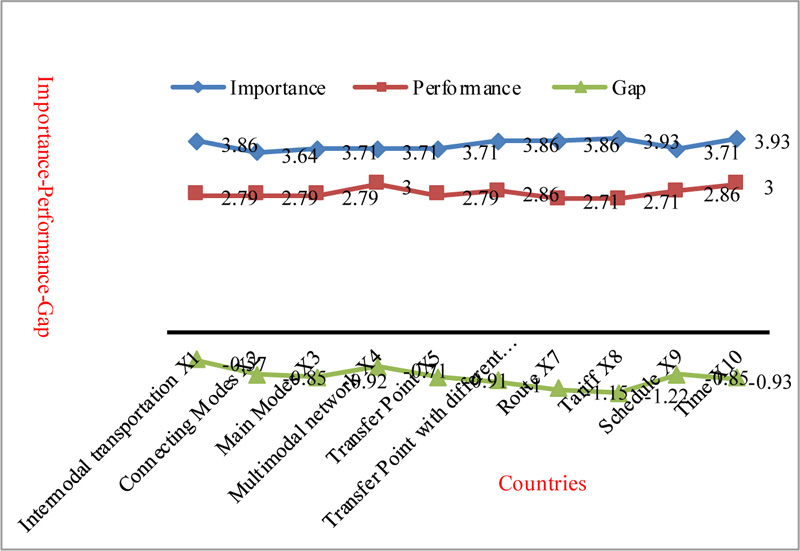
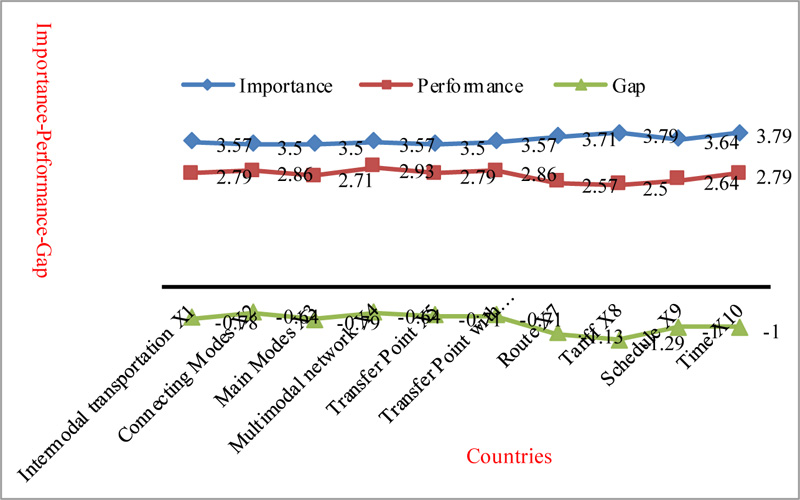
| Code | Variable | Importance | Performance | Gap | ||
|---|---|---|---|---|---|---|
| Respondents Number | Average Value | Respondents Number | Average Value | |||
| X1 | Intermodal transportation | 243 | 3,57 | 243 | 2,79 | -0.78 |
| X2 | Connecting Modes | 243 | 3,5 | 243 | 2,86 | -0.64 |
| X3 | Main Modes | 243 | 3,5 | 243 | 2,71 | -0.79 |
| X4 | Multimodal network | 243 | 3,57 | 243 | 2,93 | -0.64 |
| X5 | Transfer Point | 243 | 3,5 | 243 | 2,79 | -0.71 |
| X6 | Transfer Point with different network | 243 | 3,57 | 243 | 2,86 | -0.71 |
| X7 | Route | 243 | 3,71 | 243 | 2,57 | -1.14 |
| X8 | Tariff | 243 | 3,79 | 243 | 2,50 | -1.29 |
| X9 | Schedule | 243 | 3,64 | 243 | 2,64 | -1 |
| X10 | Time | 243 | 3,79 | 243 | 2,79 | -1 |
| Average | 3,614 | 2,74 | -0.87 | |||
| Source: processed from primary data, Surabaya, 2020 | ||||||
3.9. Integration of transportation modes at Tanjung Perak Port
Another point of departure apart from those previously mentioned is the Tanjung Perak Port, Surabaya. It was, however, discovered that no other transportation mode has been integrated into this port as shown in Table 5. Therefore, tourists and visitors intending to visit the Mount Bromo area have to use public transportation around the port which is traveling to Bungurasih/Purubaya Terminal, where they are expected to board the Damri bus. This mode is expected to take them to the Mount Bromo area through Sukapura, Probolinggo Regency with the departure scheduled at 08.00 am and 04.00 pm at a rate of IDR 50,000 which is equivalent to 3.3 US $. The return trip can also be through the Bungurasih Terminal Surabaya from Sukapura at 08.00 am and 04.00 pm.
The Importance-Performance Analysis in Fig. (17) and Table 6 showed the average performance value of this mode is 2.3 and this is lower than the required 3.29. Therefore, the gap between the expectations and reality for the 10 multimodal transport variables has negative values while the satisfaction index is very low with the lowest recorded to be 46.2%. This means the high expectations of the visitors for the multimodal variables have not been fulfilled.
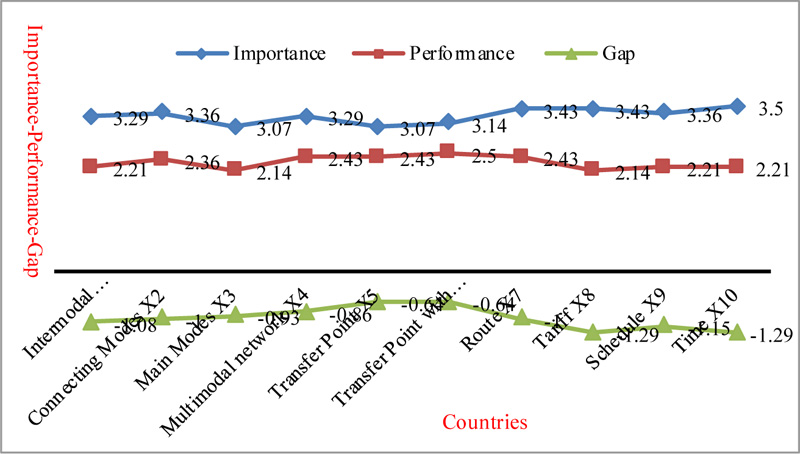
| Starting point | Variable | |||||||||
| X1 | X2 | X3 | X4 | X5 | X6 | X7 | X8 | X9 | X10 | |
| Juanda International Airport | Avail | Avail | Avail | Avail | Avail | Avail | Avail | Avail | Avail | Available |
| Abdul Rachman Saleh Airport | Avail | Avail | Avail | Avail | Avail | Avail | Avail | Avail | Avail | Available |
| Gubeng Railway Station | Avail | Avail | Avail | Avail | Avail | Avail | Avail | Avail | Avail | Available |
| Pasar Turi Railway Station | Avail | Avail | Avail | Avail | Avail | Avail | Avail | Avail | Avail | Available |
| Tanjung Perak Port | Unavail | Unavail | Unavail | Incomplete | Incomplete | Incomplete | Unavail | Unavail | Unavail | Unavail |
| Code | Variable | Importance | Performance | Gap | ||
|---|---|---|---|---|---|---|
| Respondents Number | Average Value | Respondents Number | Average Value | |||
| X1 | Intermodal transportation | 243 | 3.29 | 243 | 2.21 | -1.08 |
| X2 | Connecting Modes | 243 | 3.36 | 243 | 2.36 | -1 |
| X3 | Main Modes | 243 | 3.07 | 243 | 2.14 | -0.93 |
| X4 | Multimodal network | 243 | 3.29 | 243 | 2.43 | -0.86 |
| X5 | Transfer Point | 243 | 3.07 | 243 | 2.43 | -0.64 |
| X6 | Transfer Point with different network | 243 | 3.14 | 243 | 2.5 | -0.64 |
| X7 | Route | 243 | 3.43 | 243 | 2.43 | -1 |
| X8 | Tariff | 243 | 3.43 | 243 | 2.14 | -1.29 |
| X9 | Schedule | 243 | 3.36 | 243 | 2.21 | -1.15 |
| X10 | Time | 243 | 3.5 | 243 | 2.21 | -1.29 |
| Average | 3.29 | 2.3 | -0.99 | |||
3.10. Findings of Integration Conditions in TN-BTS
The findings in the field related to the implementation of transportation in the TN-BTS area are as follows. Accessibility is not good, this is indicated by the number of damaged and narrow roads with a width of 3 m, and no street lights. Connectivity, not well connected, this is indicated by the limited public transport services. Next is the problem of integration, namely: there is no integration between modes and there is no integration of tariffs. other things are the presence of illegal service officers, lack of road equipment, namely road markings, traffic signs, safety fences, and road markers, unrepresentative parking areas, lack of public facilities such as places of worship, toilets, and hot water, limited tourism information centers, limited complaints, lack of tow trucks, poor drainage, unavailability of shuttles, there is still overlap between the Probolinggo - Cemoro Lawang (Mist. Elf) bus terminal line and the Sukapura - Cemoro Lawang (Hardtop) route.
In the future, it is necessary to think about the development of an External Environment for Sustainable Bike Sharing in tourist areas such as TN-BTS. Must focus on related factors with cycling and mobility promotion programs within the city; free public bike ride to jobs, schools, and universities; environmental friendliness public bicycle use [32].
In addition, it is also necessary to think about providing Park and Ride (P&R) facilities to make it easier for users to leave their vehicles.On the outskirts of the city and continue the journey to the city center using public facilities transportation, such as buses, trams, trolleybuses, subways, trains, or bicycles. However, there are many factors that determine the success of P&R, especially including an efficient public transport system, especially with the presence of transport links near P&R and significant traffic volume on the transport network at the hub which means the driver has a lot of delays, having problems by finding free parking spaces, and facing high parking fees, and more other factors [33].
CONCLUSION
The COVID-19 pandemic hit the world when the East Java Provincial Government started developing the tourism sector of its region. The focus is on five development areas, one of which is TN-BTS, and the transportation integration aspect is observed to be very important to the success of the development.
The integration of different modes of transportation integration in this area, however, needs to fulfill certain elements such as the need for connecting modes, main modes, multimodal networks, transitional facilities and with different networks, integrated schedules, tariffs, routes, and times.
The findings showed there are four main entrances to TN-BTS, especially the Bromo area, and these include the Juanda International Airport, Malang Abdul Rachman Saleh Airport, Surabaya Gubeng Railway Station, and Pasar Turi Railway Station Surabaya. These entrances were observed to have integrated Damri bus land transportation mode in their system but the quality is very low with satisfaction level values recorded to be lower than 60%. Moreover, another entrance is the Tanjung Perak Port, Surabaya but it was discovered not have any transportation mode integrated into its system, and the tourists entering through the port are required to change modes by using city bus transportation to reach the Bungurasih or Purubaya station and then board Damri bus to reach the tourist areas via the Toll.
The spread of the COVID-19 pandemic has caused communities to reduce their desire to travel and the same was observed in East Java with the Provincial Government restricting the movement of the people to a certain place. Tourism, entertainment, cafes, restaurants, and schools were also temporarily closed and this makes it increasingly difficult to achieve the transportation integration plans. This is evident from the very low community satisfaction index values recorded for the transportation integration assessment in the TN-BTS area as well as the inability to fulfill the high expectations of visitors based on the performance of the multimodal variables.
This means there is a need to integrate more transportation modes in the TN-BTS area such as the inclusion of trains or land in Tanjung Perak Surabaya and Tanjung Tembaga Probolinggo Ports. It is also important to increase the connecting mode, main mode, multimodal network, transfer facilities and with different networks, integrating routes, tariffs, and intermodal schedules as well as the time between the modes.
LIST OF ABBREVIATIONS
| CSI | = Customer Satisfaction Index |
| IPA | = Important Performance Analysis |
AUTHORS’ CONTRIBUTIONS
The writing team consisted of nine people, with the main author being Drs. Priyambodo, MPM, DESS, Dr. Ir. Abdul Hamid, Dr. Ari Sasmoko Adi, Dewi Gartika, SSi, Msi, Momon, S.SiT, Msc, Suroso, S.Pd, MT, who came up with the idea of writing this script.
The material preparation, data collection, and processing were assisted by Endriana Wahyu Alita, S.Sos, Kristian Buditiawan, ST, Dendy Setyawan, ST, MSi, The final manuscript, written by Drs. Priyambodo, MPM, DESS, was also read and approved by all the authors.
Hence, it is stated truthfully that the authors are willing to take responsibility for the non-conformities due to any observed discrepancy.
CONSENT FOR PUBLICATION
Not applicable.
FUNDING
This research was funded by the Research and Development Agency of East Java Province, Government of the Republic of Indonesia through the 2019 Regional Budget (APBD).
CONFLICT OF INTEREST
The authors declare that they have no competing interests.
ACKNOWLEDGMENTS
The authors are grateful to the TN-BTS Malang Regency manager for providing valuable data and information to improve the quality of this research as well as the Research and Development Agency of East Java Province for the supports.


